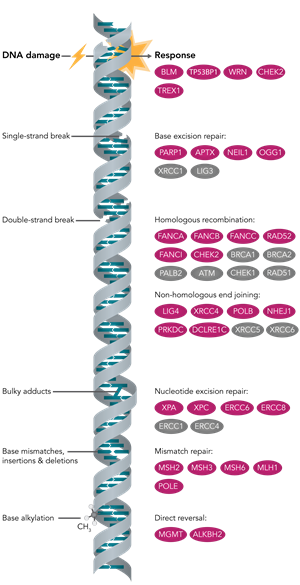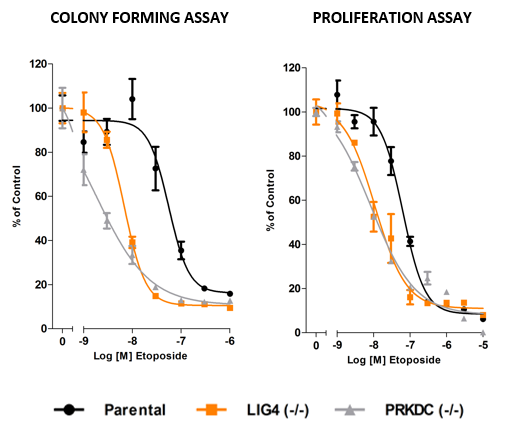Overview of DNA damage repair mechanisms

DNA is constantly exposed to a variety of damaging factors such as genotoxic agents, environmental factors (e.g. UV light, irradiation) or normal metabolic activities (e.g. nucleotide mis-incorporation during DNA replication, reactive oxygen species) that causes a range of lesions. DNA repair pathways are constantly active in the cell to identify and correct all DNA damage that may occur. The wide diversity of DNA lesions requires multiple, largely distinct DNA repair processes.
The DNA repair machinery is vital for the maintenance of genome integrity and for the proper function and survival of all organisms. A cell that has accumulated a large number of lesions can either undergo apoptosis, senescence, or in the case of cancers; unregulated cell division. A failure to repair DNA lesions can result in mutagenesis, large scale genome aberrations and cellular cytotoxicity.
This collection has been generated in close collaboration with Joanna I. Loizou (CeMM, Research Center for Molecular Medicine of the Austrian Academy of Sciences, Vienna, Austria).
Case study
The response of LIG4 (LIGIV) and PRKDC (DNA-PKc) (-/-) cell lines to treatment with Etoposide was studied. These proteins play a role in Non-Homologous End Joining (NHEJ) and they are both associated with disease; LIG4 is associated with T cell leukemia whilst loss of PRKDC has been linked to gastric tumors.


DNA repair Assays
LIG4 and PRKDC (-/-) cells show selective sensitivity to Etoposide over HCT116 Parental cells in an 8 day colony forming assay and a 96 hour proliferation assay.
Cell lines used
|
Cell Line |
Genotype |
|---|---|
|
HCT116 |
LIG4 (-/-) |
|
HCT116 |
PRKDC (-/-) |
Explore our popular knockout cell lines for DNA damage
| TP53BP1 | |||
|
|
|||
|
|
Order products
Human knockout HAP-1 cells
The single largest bank of isogenic cell lines with over 7,500 cell lines to choose from and trusted by academia, biotech, and pharma research labs.
Cancer-related cell lines
Choose from over 300 knock-in and knockout cell line models in many standard cancer cell lines such as DLD1, MCF10A, and HCT116.
Cas9 Stable Cell Lines
Simplify gene editing experiments with stably expressing Cas9 cell lines
CRISPRmod CRISPRa dCas9-VPR Stable Cell Lines
Streamline CRISPR activation experiments with stably expressing dCas9-VPR cell lines
Helpful Resources
Cell Line Engineering Brochure
Save time and de-risk your project. With 7,500 readymade knockouts from Horizon you can validate your research without having to invest valuable time, money, and resources.
Learn more
Top peer reviewed scientific articles using HAP1 cell lines
Need help?
Can't find the right cell model for your research?
Our Express and Custom engineering services could help you.
